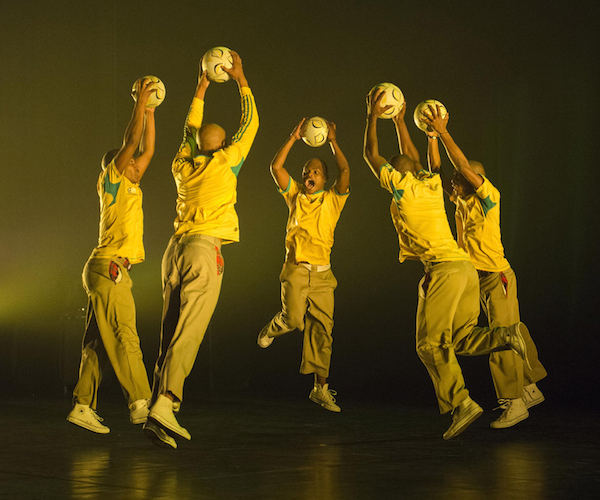Dance Review: Festival of South African Dance — Sheer Exhilaration
An evening-length festival of Gumboot and Pantsula at Rhode Island College featured a large cast of virtuosic dancers and engaging musicians.
Festival of South African Dance, Featuring the Gumboots and Pantsula Dance Companies presented by The Performing Arts Series at Rhode Island College in Roberts Hall, 600 Mt. Pleasant Avenue, Providence, RI, on October 20.

A glimpse of the Festival of South African Dance. Photo: courtesy of Rhode Island College.
By Mary Paula Hunter
Two traditions of South African dance emerged out of the country’s hardships: The Gumboot style was created by South African men toiling in the diamond mines and the Pantsula tradition, a quick-footed release performed after-hours by men forced to migrate from ancestral homes to townships where they worked as day laborers, often in sub-human conditions.
An evening length festival of Gumboot and Pantsula at Rhode Island College featured a large cast of virtuosic dancers and engaging musicians, an assemblage that managed to transform the institution’s sterile Roberts Hall into a compendium of the infectious sounds and movements of South Africa.
The first half of the program highlighted Gumboot. This body-as-instrument dance style goes back to the mid-19th century, taking its name from the rubber boots issued to miners who stood in pools of water as they worked in the dank mines. Anyone familiar with African-American Step Dancing will immediately recognize its ancestry in the Gumboot style.
But, unlike Step, Gumboot fuses song and dance in order to tell a story. The opener, We Mama, dramatizes the fear of entering the mines for the first time. Namhlangifayo mourns those who died in the mines and the suffering of impoverished families. Throughout the dances, lyrics and steps are knit into folk tales that record the history of miners grateful for a job but lonely and isolated as they lived for long months away from family. Forced to work in silence, they shook ankle bells to communicate; thus a rhythmic language was born in the dark.
Characterized by body slapping, clapping, and stomping, Gumboot is further defined by the mesmerizing sound of the rubber boot smacking the floor as well as the ankle bells, whose rings served as a reminder that there was a brighter life above ground. At RIC, the five skillful performers (Thanduxolo Mhlongo, Thulani Meyiwa, Ktlego Makgopela, Mlingwa Mayo, and Owen Mabuza — of Gumboots Simela, a troupe directed by Thupelo Motluong) slapped and clapped every part of their bodies in intricate rhythmic patterns. It was as if these performers were playing two or three percussive instruments at once.
Month End, a piece that celebrates pay day, concluded the hour-long dance-drama. A subtitle or two would’ve helped comprehension, especially during the work’s mournful ballads. But, for the most part, the body proved to be a more-than-able communicator.
The second half of the evening featured the Red Actions Pantsula, a company founded by Sello Reuben Modiga in Orange Farm, a town outside of Johannesburg. Modiga’s goal in forming the company was to harness the talents of at-risk youth by having them master the performance demands of Pantsula.
Pantsula dates to the ’50s, when a campaign to isolate races through forced migration reached its apex. Male day-laborers, separated from family and home, released their anger and frustration by creating a highly improvised (and competitive) style that combines elements of the Sotho dance as well as the syncopation that energized American jazz of the ’30s. In time, Pantsula incorporated elements of hip hop and break dancing; from its beginnings, though, the dance’s focus was on social commentary. Apartheid, the spread of Aids, and the abuses of government have been representative themes.
Modiga begins the Pantsula section with a sequence picturing men crammed into dormitories. They intermixed miming the actions of work (construction, janitorial, etc) with pure Pantsula. At times, the viewer yearned for a good editor; too much fancy footwork dulled the senses, as did the over-reliance on electronic music.
Near the end of the program, as the DJ left his podium to entertain with a break dance, one longed for the clarity of the Gumboot style. Parsing Pantsula’s various influences — native dance, American jazz and pop, hip hop, and break dancing — became nearly impossible. Too many repetitive dances muddied the waters further, eventually fatiguing the senses. But the finale, in which the Gumboot dancers joined the Pantsula performers in a display of dazzling fireworks, served up an exhilarating — and clarifying — vision.
Mary Paula Hunter lives in Providence, RI. She’s the 2014 Pell Award Winner for service to the Arts in RI. She is a choreographer and a writer who creates and performs her own text-based movement pieces.
